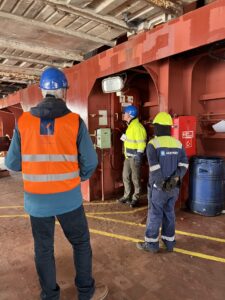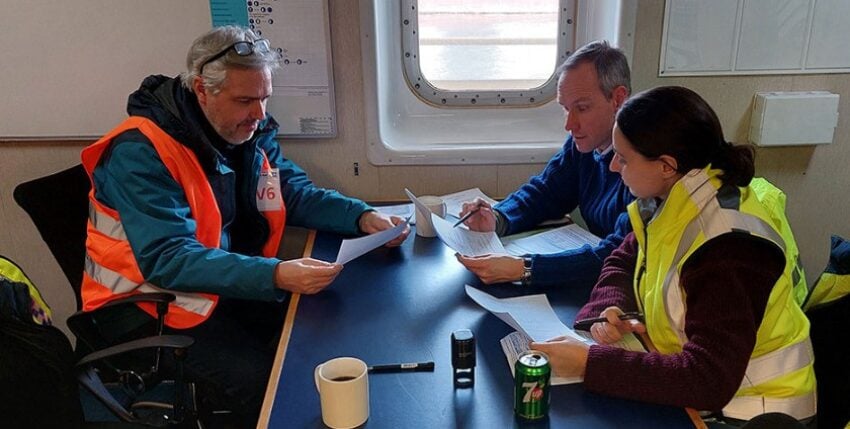Internationally agreed rules are designed to protect seagoing vessels and their crews from external dangers. The inspectors from the Federal Maritime and Hydrographic Agency work with their police colleagues to ensure compliance.
"Thank you very much for your cooperation, captain!" Manfred Feindt concludes the inspection on board a container ship in the port of Hamburg. Feindt is a nautical inspector at the Federal Maritime and Hydrographic Agency (BSH) and works in the S 42 Maritime Defence Division. Today he has three police officers from the Hamburg Waterway Police in his entourage. They are new to their posts and are accompanying him to learn what is important during inspections under the International Ship and Port Facility Security Code, the ISPS Code. Feindt explains: "The BSH is responsible for the implementation of and compliance with the ISPS Code on ships flying the German flag in accordance with the Maritime Duties Act and also inspects ships flying foreign flags that call at German ports. We check the validity of the ship security certificate (ISSC) and other safety-related documents. This also includes a tour of the ship, as security-sensitive areas must be protected against unauthorised access."

Preventing unauthorised persons from gaining access to ships and port facilities is a central concern of the ISPS Code. It was created in 2002 after the terrorist attacks in New York, as there was and still is great concern that criminals could seize a ship and use it to cause damage. But it is not only terrorists or pirates who pose a threat. Chapter XI-2 of the International Convention for the Safety of Life at Sea (Solas) recognises other security-relevant events that could threaten the safety of ships or port facilities. More specifically, European Regulation (EC) 725/2004 refers to "... intentional unlawful acts which may cause damage to ships, their passengers or cargo and the port facilities serving them." (Art. 2 para. 13). To prevent precisely this, the shipping companies draw up an individual Ship Security Assessment (SSA) for each of their ships. This threat analysis takes into account factors such as sailing area, cargo, ship type and number of crew. "Of course, the threat situation for a small bulk carrier travelling in the Baltic Sea is different to that of a tanker, for example, which sails in areas with frequent piracy incidents," explains Manfred Feindt. "Nevertheless, the requirements of the ISPS Code are binding for all ships over 500 GT on international voyages and for passenger ships under 500 GT."
The risk assessment by the SSA is therefore an important tool for the next step, the development of the security plan. It is also customised for each individual ship to ensure the best possible protection. The plan takes into account particularly vulnerable areas of the ship, which are labelled as restricted areas, and specifies the measures that the crew must take at sea and in port to prevent unauthorised access to the ship. Under the Solas Convention, states have the option of increasing security levels in response to a changing threat situation. The security plan therefore contains measures adapted to the respective level. The security levels range from level 1, normal operation, to security level 3, where there is a specific threat, for example a bomb threat.
Finally, based on the approved plan and its verification - often referred to as an audit - an on-board security certificate is issued, which is valid for five years. A review between the second and third year of the certificate is mandatory. But that's not all. In addition to the certifications described above, there are other measures to test whether the ISPS Code is being implemented correctly on board. The unannounced inspection carried out today is one of these measures and another focus of the BSH inspectors' activities.
Officers like Manfred Feindt regularly go on board on a random basis and carry out checks on foreign-flagged ships, as required by the ISPS Code and Regulation (EC) 725/2004 on enhancing ship and port facility security. "As a rule, I first look at the documentation, i.e. the ship security certificate, the crew list and the certificate of the ship security officer (SSO). But reports from security exercises are also very informative, as they prove whether the crew regularly deals with security issues and familiarises new crew members accordingly. I then go on a tour, take a look at the implementation on site and randomly question crew members about security on board." If Feindt finds any deficiencies here, he can report administrative offences, which can quickly amount to 1000 euros or more. However, the aim of the control measures is not so much to search for and find offences, but rather to bring about improvements to increase safety. "The BSH wants to optimise security measures on ships, give seafarers a healthy awareness of safety and provide practical tips. This is best achieved in a dialogue-based principle in which we all learn something," emphasises Feindt, who himself sailed on container ships for many years and was a Ship Security Officer there. He still draws on this experience, as it helps him to quickly understand the security structure of each ship. What makes sense in terms of security on a tanker can be a hindrance on a passenger ship. The 50,000 or so ships involved in maritime transport worldwide are too diverse. Experience and a sense of proportion are required here.

However, as the inspection measures in all German harbours from Emden to Wolgast cannot be carried out by the BSH alone, there is a federal-state agreement. It stipulates that police officers from the waterway police carry out the inspections on site. They receive the necessary theoretical training at the Waterway Police School in Hamburg. BSH Division S 42 is also involved here and provides lecturers for the seminar. Manfred Feindt and his colleagues regularly pass on their practical and theoretical knowledge here. Furthermore, the BSH, in co-operation with the waterway police of the coastal federal states, has drawn up instructions and several checklists for ISPS inspections. The aim is to standardise the inspections among the law enforcement officers of the various federal states. "To ensure that this succeeds, we BSH inspectors regularly visit waterway police stations along the coast. We are very grateful for the work of our police colleagues and can use this opportunity to clarify technical issues and further expand our cooperation," says Feindt.
He is very satisfied with the results of today's ship inspections. Especially with the professional approach of the young police officers. After all, all beginnings are difficult and the coronavirus pandemic has prevented law enforcement officers from being allowed on board for a long time. In this respect, a total of eight officers were pleased with the advice and explanations from their BSH colleague today. They were able to refresh their knowledge during the regular inspections, ask technical questions and are now fit to go on board themselves in the future in terms of security.
Oliver Kaus works at the Federal Maritime and Hydrographic Agency in the area of defence against external threats at sea and is a reservist in the naval command.
Oliver Kaus










